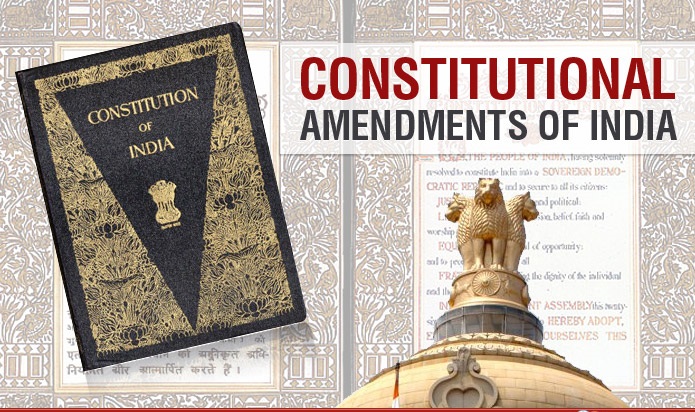Important amendments of the Indian Constitution

This article has been written by Khyati Basant, pursuing BBA LLB from Symbiosis Law School, NOIDA and Ishani Samajpati, pursuing B.A. LL.B. (Hons) under the University of Calcutta. This article consists of a depth view of the major amendments that have been done to the Indian Constitution so far.
Table of Contents
Introduction
The Constitution of India is the largest Constitution in the world. India’s Constitution is the supreme rule of law. The document sets out the framework for the demarcation of fundamental political code, structure, procedures, powers, and responsibilities of government institutions and sets out fundamental rights, guidelines, and citizens’ duties. The chairman of the drafting committee, B.R. Ambedkar, is generally regarded as the chief architect. The Constitution declares India to be a sovereign, socialist, secular, democratic republic, ensuring justice, equality, and freedom for its citizens, and endeavoring to promote brotherhood.
The original Constitution of 1950 is stored in the Parliament House in New Delhi in a helium-filled situation. During the emergency the words ‘secular’ and ‘socialist’ were added to the preamble in 1976. It was adopted by the Indian Constituent Assembly on 26 November 1949 and took effect on 26 January 1950. Article 368 of the Indian Constitution lays that the government can amend the Constitution. There are two types of amendment procedures – (i) Rigid and (ii) Flexible. Under the rigid system, it is very difficult for the people to amend the Constitution. This is followed by the Constitution of the U.S, Canada, and Australia. Whereas, the flexible procedure is where the amendment can be done in the Constitution.


The Indian Constitution is both rigid and flexible, i.e. hard to amend but virtually flexible. In compliance with Article 368 of the Indian Constitution, a provision must be made in any of the houses, which must be passed by a large majority or by a simple majority later. If a vote approves the resolution, it will be submitted to the president for his assent. In 70 years of Indian Independence, the Constitution has been amended 104 times. Starting with 395 Articles and 8 Schedules, it now stands at more than 450 Articles and 12 Schedules – arising from 104 amendments.
Constitutional amendment in India
The constitutional amendment procedure reflects the desire of the constituent legislative assembly to put in place a dynamic document. The Constitution of India provides for three distinctive amending procedures which combine flexibility and rigidity.
- Amendment by simple majority: Certain provisions can be changed by a simple majority, almost like passing an ordinary law. For instance, creation of new states, alteration in the size of states, qualification of citizenship etc.
- Amendment by the special majority: A majority of 2/3rd members for voting is required under Article 249 . To pass Rajya Sabha resolutions for making laws in the State list requires a special majority.
- Amendment by special majority and ratification by at least one half of the State Legislatures : This includes the provisions, for instance election of the President, list of subjects in the Seventh Schedule, the relationship between Centre and States etc.

Amendment of Indian Constitution – Article 368
Article 368 of the Constitution which deals with the amendment by the special majority and ratification lays down that Parliament can add, vary or repeal any provision of this Constitution in accordance with the procedure laid down.
Article 368(2) lays down that an amendment may be initiated in either House of Parliament. It has to be passed by a majority of the total membership and also by a majority of not less than two-thirds of the members of that House present and voting.
Article 368 of the Constitution of India provides for a special majority and ratification by state legislatures for amending the following articles.
- Article 54 , Article 55 , Article 73 , Article 162 or Article 241 , or
- Chapter IV of Part V , Chapter V of Part VI , or Chapter I of Part XI , or
- any of the Lists in the Seventh Schedule , or
- the representation of States in Parliament, or
- the provisions of this Article.
Under Article 368 of the Indian Constitution, the Parliament is empowered to amend it and its procedures. Amendments to the Indian Constitution are not easy to produce and require compliance with other provisions. Article 368 grants Parliament some powers allowing it to amend it while keeping its fundamental form just the same. Article 368 of the Constitution of India cites two types of amendments to the Constitution of India. The form of amendment is by a simple legislative majority (Lok Sabha & Rajya Sabha), the second type of amendment is by a special parliamentary majority, and the third type is with the approval of a special majority and by half the total state.
Reason for Amendment Procedure by Article 368
Time is not static, it’s continuing to change. The Constitution needs to be revised. People’s social, cultural, and political situation is starting to shift. If the constitutional changes were not made, we would not be able to encounter the future difficulties and it would become a hurdle in the path of development. There is an explanation of why our founding fathers made the Constitution as robust as it is today. It is to ensure the plans are changing with the country’s growth. Therefore, according to Article 368, Parliament’s powers to amend the Constitution are unlimited in respect of parts of the Constitution that it wishes to amend.
The basic structure of the Indian Constitution
In the Kesavanand Bharati case of 1973, the Supreme Court ruled that the Parliament could not change certain provisions which constitute the basic constitutional framework. Constitutional ideologies which are essential to constitutional survival. Some examples are Free and Fair Election, the nation’s Federal nature, Judicial Review, and Power Separation. It notes that some basic legislative frameworks and founding values constitute the foundation of the Constitution. These cannot be touched by anyone.

Major Amendments in the Constitution
First Amendment, 1951
- The Constitution (First Amendment) Act, 1951 empowered the State to make special provisions to advance socially and economically backward classes.
- Savings legislation allowing for the purchase of estates, etc.
- Added Ninth Schedule to protect from judicial review the land reforms and other legislation included in it. Articles 31A and 31B were added after Article 31, respectively.
- Three more reasons for restricting freedom of speech and expression have been added: public order, friendly relations with foreign states, and incitement to an offence. It also made the restrictions ‘reasonable’ and, therefore, in nature, justiciable.
- Issues in the cases included freedom of expression, possession of Zamindari estate, State trade monopoly, etc. These laws breach property rights, freedom of speech, and equality before the law.
The Constitution (2nd Amendment) Act, 1952
- The ratio of representation of members to the population in the Lok Sabha was readjusted by relaxing Article 81(1) which states that 1 member can represent even more than 7.5 lakh people.
- This amendment removed the upper population limit by amending Article 81 of the Indian Constitution.
The Constitution (4th Amendment) Act, 1955
- This amendment fixed the ratio of compensation to be given for the compulsory acquisition of private property.
- Stated the fixing of maximum limits or holding of agricultural land that may be owned or occupied by any individual.
- Authorised the states to have full control over mineral and oil resources. The powers of cancellation or modification of the terms and conditions of any related licenses, mining leases and similar agreements were also handed over.
- Authorised the state to nationalise any commercial or industrial undertaking.
- Included some more Acts in the Ninth Schedule.
- Amended Article 31(2) with regards to acquisition or requisition of public property and transfer of the ownership or right to possession of any property to the State.
- Extended the scope of Article 31 A (savings of laws).
The Constitution (7th Amendment), 1956
- Second and seventh schedules have been revised.
- The current division of states into four divisions (i.e., Part A, Part B, Part C, and Part D states) was repealed and reorganized into 14 states and 6 federal territories.
- Extended high court authority to union territories.
- Provided for two or more States to establish a common high court.
- Provided that additional and acting High Court judges are appointed.
- Implementing the State Reorganization Committee recommendations, and implementing 1956, State Reorganization Act . Linguistic reorganization of States. Class A, B, C, and D discontinued.
The Constitution (8th Amendment) Act, 1959
- This amendment amended Article 334 of the Constitution.
- Extended the period of reservation of seats for the Scheduled Castes and Scheduled Tribes and the Anglo-Indians in the Lok Sabha and the State Legislative Assemblies.
- Earlier, the reservation period was for ten years. Through this amendment, it was extended upto twenty years.
The Constitution (9th Amendment Act),1960
- Facilitated the cession to Pakistan of the Berubari Union Indian territories (located in West Bengal) as provided for in the Indo-Pakistan Agreement (1958). Schedule 1 of the Constitution was amended.
- Adjustments to Indian territory as a result of an agreement with Pakistan. After this Union referred the matter to SC, which ruled that the Parliament’s right to decrease a state’s area (under Article 3 ) did not include the cession of Indian territories to a foreign government. Indian territory can therefore, only be ceded to a foreign State by amending the Constitution pursuant to Article 368.
The Constitution (10th Amendment Act), 1961
- Incorporation as a Union Territory of Dadra, Nagar and Haveli, as a consequence of the acquisition from Portugal.
- It amended the Constitution under Article 240 .
The Constitution (11th Amendment Act), 1961
- Changed the Vice President ‘s election procedure by providing for an electoral college, rather than a joint parliamentary meeting of the two houses.
- Provided that on the ground of any vacancy in the appropriate electoral college, the election of the President or Vice President can not be challenged.
The Constitution (12th Amendment Act), 1962
- Goa, Daman and Diu were incorporated as Union Territory in the Indian Union.
- It amended the Constitution under Article 240.
The Constitution (13th Amendment Act), 1962
- Formation of Nagaland State, with special protection provided for in Article 371A .
- Article 170 of the Constitution was modified.
The Constitution (Fourteenth Amendment) Act, 1962
- The French establishments of Pondicherry, Karikal, Mahe, and Yanam became territories of India with the ratification of the Treaty of Cession by both the Government of India and France.
- The territories were together named as Pondicherry and the number of representatives in Lok Sabha from Pondicherry was increased.
- Further, it provided for Legislatures and Councils of Ministers in the Union territories of Himachal Pradesh, Manipur, Tripura, Goa, Daman and Diu and Pondicherry.
The Constitution (15th Amendment Act), 1963
- Enabled the High Court to issue writs to any person or authority even outside the jurisdiction of its terrorist if the cause of action arises within its territorial boundaries.
- High court judges increased their retirement age from 60 to 62 years.
- Provided that retired high court judges are appointed as acting judges of the same court.
- Provided the compensatory allowance for the transfer of judges from one High Court to another.
- Allowed the retired High Court judge to act as the Supreme Court’s ad-hoc judge.
- Provided for the age determination procedure of the judges of the Supreme Court and the High Court.
The Constitution (Sixteenth Amendment) Act, 1963
- AmendedArticle 19 of the Constitution and empowered the states to restrict the rights to freedom of speech and expression and peaceful assembly in the interest and sovereignty of India.
- Amended Article 84 and Article 173 for the qualifications of members of Parliament and Legislature of State respectively.
- Included sovereignty and integrity in the oaths or affirmations for the members of the legislatures, ministers, judges and CAG of India.
The Constitution (Seventeenth Amendment) Act, 1964
- AmendedArticle 31A and provides that the acquisition of any land under personal cultivation by the state shall be held unlawful without payment of compensation equal to the market value.
- Amended the Ninth Schedule and added 44 state acts relating to land matters.
The Constitution (Eighteenth Amendment) Act, 1966
- Through the amendment of Article 3 of the Constitution, this amendment clarified that the power conferred on the Parliament also includes the power to form a new state by uniting part of any state or Union territories to any other.
- Created the new states of Punjab and Haryana.
The Constitution (Nineteenth Amendment) Act, 1966
- Article 324(1) of the Constitution regarding superintendence and control was amended .
- Appointment of an election tribunal to settle disputes regarding the Parliament or state elections was abolished.
- The amendment also enabled the trial of election petitions by the High Courts.
The Constitution (Twenty-first Amendment) Act, 1967
Sindhi language was included in the Eighth Schedule to the Constitution. The significance of this amendment was that though Sindhi was not a regional language in India, it was one of the important languages in undivided India. Hence, Sindhi language was included in the Eighth Schedule as the 12th language.

The Constitution (24th Amendment Act),1971
- Affirmed Parliament’s authority, by amending Articles 13 and 368, to change every aspect of the Constitution including constitutional rights.
- Made it compulsory that the President give his approval to a Constitutional Amendment Bill.
- The Twenty-fourth Constitutional Amendment Act was introduced in reaction to the Supreme Court’s Golaknath decision (1967) , which ruled that the Parliament has no authority to revoke constitutional freedoms by amending the Constitution.
The Constitution (Twenty-fifth Amendment) Act, 1971
- The fundamental right to property was curtailed. It became a constitutional right by the amendment of Article 31, now removed.
- The amendment specifically stated that any legal authority can take the acquisition or requisition of a property after the payment of proper compensation.
- Through the insertion of new Article 31 C , it provided that any law passed under Directives of State Policy in Article 39(b) and (c) cannot be challenged on the ground that it removes or reduces any of the rights as provided under Article 14 , 19 or 31.
The Constitution (Twenty-seventh Amendment) Act, 1971
- The then Union Territory of Mizoram was contemplated into the scheme of reorganisation of the north-eastern areas. Through the amendment , Article 239A dealing with the creation of local legislatures or Council of Ministers or both for certain Union territories, Mizoram was conferred the power to have a legislature and Council of Ministers.
- A new article, 239B was inserted which provided the power to enforce Ordinances during the recess of the Legislature.
- Another new article, 371C was added which provided special powers to the State of Manipur.
The Constitution (26th Amendment Act), 1971
- Abolished the privy purses and privileges of the former rulers of princely states.
- Changes were made in Article 366 . Added Article 363A and Removed Articles 291 and 362 .
The Constitution (31st Amendment Act), 1973
- The seats in Lok Sabha were increased from 525 to 545.
- This was done because of the increase in the population of the country.
- In the 31st amendment of the Indian Constitution, Article 330 of the Indian Constitution, which provides the reservation of seats in the Lok Sabha for Scheduled Castes and Scheduled Tribes was held inapplicable for the tribal areas of Assam, Nagaland, Meghalaya, Arunachal Pradesh; and in Mizoram due to their significant tribal population.
- Article 332 regarding the reservation of seats in Legislative Assemblies in states was also held inapplicable in the tribal areas of Assam, in Nagaland and in Meghalaya.
The Constitution (Thirty-second Amendment) Act, 1973
- The amendment provided special provisions in respect of admission to educational institutions and public employment, especially in civil services and the constitution of an Administrative Tribunal with jurisdiction to deal with disputes and grievances regarding public services.
- Provided a provision to establish a Central university in Andhra Pradesh.
- Amended the Seventh Schedule of the Constitution.
The Constitution (Thirty-third Amendment) Act, 1974
- AmendedArticle 101 and Article 190.
- Provided that the resignation of the members of Parliament and the state legislatures should be handwritten and addressed to the Chairman or the Speaker. The resignation should only be accepted by the Speaker/Chairman only if he/she is satisfied that the resignation is voluntary or genuine. If not, the resignation shall not be accepted.
The Constitution (Thirty-fifth Amendment) Act, 1974
- Sikkim was associated with the Indian Union.
- The Tenth Schedule was added which provided the terms and conditions in regards to the association of Sikkim with the Indian Union in this amendment .
The Constitution (36th Amendment Act), 1975
- Sikkim became the 22nd state of Indian Union.
- The 10th schedule was omitted.
The Constitution (37th Amendment Act), 1975
- Parliament passed it on April 26, 1975, to make way for a Legislative Assembly and a Council of Ministers for Arunachal Pradesh, the north-westernmost Union territory of the country.
The Constitution (Thirty-eighth Amendment) Act, 1975
- Articles 123 , 213 , 239B , 352 , 356 , 359 and 360 of the Constitution with regards to various powers and control of the President were amended.
- The amendment of Articles 123, 213 and 239B in regards to the promulgation of Ordinances President, Governor or Administrator respectively when the legislature is not in session is final and conclusive, not justiciable and cannot be questioned in a court of law, as provided by the amendment .
- Under this amendment, the power to declare an emergency by the President under Article 352, the power to run the government under Article 356 and the power to declare a financial emergency under Article 360 is final and conclusive and non-justiciable on any ground.
- Provided the President with the power to declare a national emergency on different grounds simultaneously.
The Constitution (39th Amendment Act), 1975
- The Bill was passed on August 7 by the Lok Sabha, and on August 9, 1975, it received presidential assent.
- The Act places in court the election of a person holding the office of Prime Minister or Speaker to Parliament, and the election of President and Vice-President, beyond challenge.
- In the case of the State of Uttar Pradesh v. Raj Narain 1976 (2) SCR 347 , Article 329A was struck down by the Supreme Court for breach of the basic structure.

The Constitution (40th Amendment Act), 1976
- The Parliament was allowed to determine from time to time the borders of the territorial waters, the continental shelf, the Exclusive Economic Zone (EEZ) and India ‘s maritime zones.
- Included in the 9th Schedule 64 more Central and State laws, mostly concerning land reforms.
The Constitution (42nd Amendment Act), 1976
- In the Preamble, three additional terms (i.e. socialist, secular, and integrity) were included.
- The 42nd amendment is the most comprehensive amendment in the history of Indian Constitutional Amendments. It consisted of 59 clauses and carried out so many changes that it has been termed as a “Mini Constitution”.
- The citizens have added fundamental duties (new part IV A).
- The President was made bound by the cabinet ‘s advice. Except for administrative and other matters tribunals (Added Part XIV A).
- Froze the Lok Sabha seats and the state legislatures on the basis of the 1971 census up to 2001 — Population Management Mechanism. The constitutional amendments were made without judicial review.
- The Supreme Court and high courts had curtailed the power of judicial review and written jurisdiction. Raised Lok Sabha tenure and state legislatures from 5 to 6 years.
- Added three new guidelines, namely equal justice and free legal assistance, employee participation in industry management and environmental protection, forests and wildlife.
- Facilitated declaration of a national emergency within a portion of India’s territories. Extended the one-time period of the law of the President of a State from six months to a year.
- Empowered the Center to deploy its armed forces to deal with a serious law and order situation in any state.
- Shifted five subjects from the state list to the concurrent list, namely education, forests, wildlife and bird protection, weights and measures and the administration of justice, constitution and organization of all courts except the Supreme Court and the high courts.
- The Parliament was empowered to determine the rights and responsibilities of its members and commissions from time to time. Established for the development of the Judicial Service of all India.
The Constitution (43rd Amendment Act), 1978
- This Act repeals the egregious fundamental clauses (42nd Amendment) legislation enacted during the Emergency. It restores civil liberties by deleting Article 31D which gave Parliament powers to curtail even legitimate trade union activity under the guise of anti-national activity prevention legislation.
- The new law, which, in accordance with the Constitution, has been ratified by more than half of the States, also restores legislative powers for the States to provide adequate provision for anti-national activities consistent with the fundamental rights. The Legislation also restored the judiciary to its rightful place.
- The Supreme Court will now have the power to invalidate state laws, a power which the 42nd Amendment Act takes away. The High Courts would now be able to resolve the question of the statutory legitimacy of Central Legislation requiring citizens residing in remote areas to seek timely justice without having to come before the Supreme Court.
The Constitution (44th Amendment Act), 1978
- Replaced the term ‘internal disturbance’ with the term ‘armed rebellion’ concerning the national emergency.
- Has made the President declare a national emergency only on the cabinet ‘s written recommendation.
- Has rendered some constitutional provisions for a national emergency and the law of the Constitution.
- Deleted the right to property from the Fundamental Rights register, and made it a legal right instead.
- Provided that, during a national emergency, the fundamental rights guaranteed by Articles 20 and 21 can not be suspended.
- The original term of the Lok Sabha and the state legislatures (i.e., 5 years) was restored.
- Restored the rules in Parliament and state legislatures on quorum.
- Reference to the British House of Commons in the parliamentary privileges provisions were omitted.
- Gave fundamental immunity of the publishing of truthful accounts of legislative trials and state assemblies in a journal.
- The President was allowed to give the cabinet ‘s recommendations back once for reconsideration. The reconsidered opinion, however, is to be binding on the President.
The Constitution (Forty-sixth Amendment) Act, 1982
- This amendment provided the states the measures to prevent the avoidance of tax in various ways.
- Assigned the states to collect the levy of tax on the consignment of goods at the place of business in inter-State trade or commerce.
- Specified restrictions and conditions in regard to the system of levy, rates and other incidents of the tax on the transfer of goods involved in the execution of a works contract, on the delivery of goods on hire-purchase or any system of payment by installments and on the right to use any goods.
The Constitution (Forty-seventh Amendment) Act, 1984
- This amendment included 14 land reform acts of various states of Assam, Bihar, Haryana, Tamil Nadu, Uttar Pradesh, West Bengal, Goa, Daman, and Diu in the Ninth Schedule.
The Constitution (Forty-ninth Amendment) Act, 1984
- Provided constitutional sanctity to the autonomous District Council of Tripura.
The Constitution (Fiftieth Amendment) Act, 1984
- Through this amendment by means of Article 33 , the government was empowered to restrict the fundamental rights of the persons employed in armed forces, intelligence organisations, and telecommunication systems set up for the purposes of any Force, bureau, or organisation to ensure discipline and proper discharge of duty.
The Constitution (52nd Amendment Act), 1985
- Provided for disqualification on the ground of defection of parliamentary members and state legislatures, and added a new Tenth Schedule containing the details in this regard.
- It introduced anti-defection laws through the addition of a new Tenth Schedule in order to prevent the mischief of political defections lured by power or material benefits.
- The 52nd amendment was unanimously adopted by both houses of Parliament.
- The Act made defection of another party unlawful after elections. Any member who defects after elections to another party will be disqualified from being a member of parliament or a legislature of the state.
The Constitution (58th Amendment Act), 1987
- Provided for an authoritative text of the Constitution in Hindi language and gave the Hindi version of the Constitution the same legal sanctity.
- This calls for special provisions for reserving seats for Scheduled Tribes in Arunachal Pradesh, Nagaland, Mizoram and Meghalaya states. Upon amending Article 322 the seating change was suspended until 2000 A.D.
The Constitution (61st Amendment Act), 1989
- Reduced the voting age for Lok Sabha and state legislative assembly elections from 21 years to 18 years.
- That was explained by the then Prime Minister Rajiv Gandhi as an expression of the full faith of the government in the country’s youth. The youth are educated and knowledgeable, and therefore, lowering the voting age will provide the nation’s unrepresented youth with an ability to let their emotions out and encourage them to potentially become part of the democratic process.
The Constitution (62nd Amendment Act), 1989
- It called for the extension for another ten years of reservation of seats for the Scheduled Castes and Tribes in Parliament and State Legislatures and reservation for election for the Anglo Indian population.
The Constitution (65th Amendment Act), 1990
- Article 338 of the Constitution has been amended to establish a National Commission for Scheduled Castes and Scheduled Tribes consisting of a Chairperson, a Vice-Chairperson and five other members appointed by a warrant under the Chairperson ‘s control and seal.
The Constitution (69th Amendment Act), 1991
- The Act of Parliament was to award Delhi Statehood as the ‘Delhi National Capital Territory’. This also provides for Delhi with a 70 member assembly and a 7 member ministerial council.
The Constitution (71st Amendment Act), 1992
- The amendment enables the inclusion of Nepali, Manipuri, and Konkani into the Constitution’s Eighth Schedule. The number of languages in the Eighth Schedule ascends to 18 with the inclusion of these three languages.
The Constitution (73rd Amendment Act), 1992
- On 22 December 1992, the Parliament passed the Seventy-third Constitutional Amendment Act, 1992, which was notified by the Central Government via the Official Gazette on 20 April 1993, when it was rectified by the legislators of the State and authorised by the President of India. The Panchayati Raj institutions have now become constitutional Legitimacy.
- Since Part VIII of the Constitution, a new section IX was added to the Constitution, with the inclusion of the powers and duties of Panchayati Raj Institutions in Article 243A and the fresh schedule called the Eleventh Schedule. The Act provides for Gram Sabha, a Panchayati Raj three-tier model, reservation of seats for SCs and STs in proportion to their population, and reservation of one-third seats for women.
The Constitution (Seventy-fourth Amendment) Act, 1992
- Granted constitutional status and protection to the urban local bodies.
- Part IX-A was added under the Amendment as the municipalities
- A new Twelfth Schedule was introduced which contains 18 functional duties to be executed by the municipalities.
The Constitution (76th Amendment Act), 1994
- This Amendment Act increases the reservation limit for government employment and admission seats in educational institutions to 69 per cent in Tamil Nadu in favour of socially and educationally deprived classes. Additionally, the Amendment Act was included in the Constitution’s Ninth Schedule to exempt it from the jurisdiction of judicial scrutiny.
The Constitution (77th Amendment Act), 1995
- This amendment has added a new clause (4-a) to Article 16 of the Constitution which empowers the State to make any reservation provisions in favour of SCs and STs in promotions in government jobs where it is of the opinion that they are inadequately represented in state services. This was done to nullify the effect of the judgment of the Supreme Court in the case of the Mandal Commission ( Indra Sawhney vs. Union of India ), in which the Court held that quotas on promotions can not be made.
The Constitution (80th Amendment Act), 2000
- The Constitution (Eightieth Amendment) Act, 2000 , introduced an alternate scheme for the distribution of taxes between the Union and the Province, based on the recommendations of the Tenth Finance Committee. Under the current income-sharing arrangement between the Union and the States, 26% of the total revenues of Federal taxes and duties are to be transferred to the States instead of their present portion of income tax, excise duty, special excise duties, and exemptions instead of taxes on rail passenger fares.
The Constitution (81st Amendment Act), 2000
- Under this amendment, the unfulfilled vacancies of one year reserved for the Scheduled Castes and the Scheduled Tribes in compliance with the clause of Reservations made pursuant to Article 16 of the Constitution shall be regarded to be a distinct class of vacancies to be filled in every following year or year and these class of vacancies shall not be counted in accordance with the vacancies of the year in which they were filled to decide the limit of a quota of fifty percent against the existing number of vacancies of that year.
The Constitution (Eighty-Second Amendment) Act, 2000
- This amendment restored the relaxation in respect of qualifying marks and standards of evaluation in matters of reservation in promotion in public services.
- Paved the way to make any provision in favor of it.
The Constitution (84th Amendment Act), 2001
- The Act revised the terms of Articles 82 and 170(3) of the Constitution to readjust and rationalize the geographical constituencies of the States without altering the number of seats allotted to each State in the House of People and Parliamentary Assemblies of States, including Scheduled Castes and Scheduled Tribes Constituencies, on a population-based basis determined in the 1991 census to remove the gap created by unequal population/electoral growth in different constituencies.
The Constitution (86th Amendment Act), 2002
- In order to make the right to free and compulsory education a fundamental right, the Act inserts a new Article, namely Article 21A, which confers the right to free and compulsory education on all children aged between 6 and 14 years. The Law amends the Constitution in Part-III, Part -IV, and Part-IV (A).
- One of the most critical changes, with the aid of government support, the government forced private schools to accept 25 percent of their class size from socially vulnerable or deprived classes in society by a random allocation process. This move was taken to seek to offer quality education to everyone.
The Constitution (88th Amendment Act), 2003
- Service tax collected and appropriated by the Union and States, levied by the Union. The Act amends Articles 268 , 270 and VIIth schedule.
The Constitution (Ninety-first Amendment) Act, 2003
- This amendment sought to limit the number of Council of Ministers, to debar defectors from holding public offices and to strengthen the anti-defection laws introduced by fifty second amendment .
- The total number of ministers including the Prime Minister in the central council of ministers shall not exceed 15% of the total strength of the Lok Sabha, as laid in Article 75(1A)
- A member of any house of Parliament disqualified under defection is also disqualified to get an appointment as a minister, as provided in Article 75(1B)
- In the council of ministers in the state, the total number of ministers, including the Chief Minister, shall not exceed 15% of the total strength of the legislative assembly of the state. But the total number of ministers shall not be less than 12, as provided under Article 164(1A)
- A member of any state legislative assembly who is disqualified on the ground of defection shall also be disqualified for the appointment as minister under Article 164(1B)
- Under Article 361B , a person disqualified on the ground of defection is also disqualified from holding any remunerative political post, office wholly or partially.
- The provision of the Tenth Schedule regarding anti-defection law that provided provisions of exemption from disqualification in the event of split by one-third members of the legislature has also been deleted by the amendment. It implies that a defector has no defence on grounds of splits.
The Constitution (92nd Amendment Act), 2003
- The amendment encourages the inclusion of Bodo, Dogri, Maithili, and Santhali into the constitution’s VIIIth Schedule. The number of languages in the VIIIth Schedule ascends to 22 with the inclusion of these four languages.
The Constitution (95th Amendment Act), 2010
- The amendment aims to expand the quota of seats in the Lok Sabha and States for SCs and STs, legislatures from 60 to 70 years.
The Constitution (96th Amendment Act), 2011
- Replaced Odia for Oriya in Indian Constitution 8th Schedule.
The Constitution (97th Amendment Act), 2012
- Added the words “or cooperative societies” in Article 19(l)(c) after the word “or unions” and the insertion of Article 43B i.e., Promotion of cooperative societies and added Part-IXB i.e., Co-operative societies. The amendment aims to promote cooperative economic activities which in effect support rural India develop. It is required not only to ensure the independent and democratic operation of cooperatives but also to make the management accountable to members and other stakeholders.
The Constitution (99th Amendment Act), 2014
- It called for the setting up of the National Judicial Commission.
- This amendment replaced the collegium system of appointment of judges with National Judicial Appointment Commission (NJAC) for the appointment of judges.
- Amended Article 124(2) regarding the appointment of Supreme Court judges and added Article 124A , 124B and 124C describing the constituent members, functions and Parliament’s power. The members of NJAC included the Chief Justice of India, two senior Supreme Court judges, Union law minister and two other nominated persons. The function included appointment and transfer of judges which is to be regulated by the Parliament.
- Article 127 , 128 , 217(1) , 222 , 224 and 231 was amended and the power was transferred to the NJAC instead of the President or the Chief Justice in connection with appointment of judges.
- In the case of Supreme Court Advocates-on-Record Association and another v. Union of India (2016) ,the constitutionality of this amendment was challenged. The Hon’ble Supreme Court held that the amendment violated the doctrine of Separation of Power and the independence of judiciary. It also restored the previous system of collegium and subsequently held the amendment null, void and unconstitutional.
The Constitution (100th Amendment Act), 2015
- Exchange of other enclave lands with Bangladesh. Conferring citizenship rights to enclave residents arising from the signing of the Treaty of Land Boundary Agreement (LBA) between India and Bangladesh.
The Constitution (101st Amendment Act), 2016
- Goods and Services Tax (GST) commenced on 8 September 2016 with the enactment and subsequent notices of the 101st Constitution Amendment Act, 2016.
- The constitution incorporated Articles 246A , 269A, and 279A . The amendment allowed amendments to the constitution’s 7th cycle. Union List entry 84 earlier contained duties related to cigarettes, alcoholic liquors, marijuana, Indian hemp, medicines and drugs, medicinal and bathroom arrangements. Petroleum oil, high-speed gasoline, engine spirit (petrol), natural gas, and air turbine power, cigarettes, and cigarettes goods should be listed following the amendment.
- Entry 92 has been removed (newspapers and ads published therein), they are now under GST. Entry 92-C (Service Tax) is now deleted from the list of unions. Entry 52 (entry tax for in-state sale) has now been removed from the State register.
- Entry 54, Taxes on the export or purchasing of products other than newspapers, according to the provisions of Entry 92-A of the List I have now been supplemented by Taxes on the selling of petroleum oil, high-speed gasoline, motor spirit (petroleum), natural gas, aviation turbine fuel and alcoholic spirit for human consumption, but not including the sale or distribution in the form of inter-State commerce or commerce Reference 55 (Taxes on Advertising) was omitted. Entry 62 (Luxury taxes, including taxes on entertainment, entertainment, betting and gambling) has now been replaced by these taxes only to be levied by local authorities.
The Constitution (102nd Amendment Act), 2018
- The bill seeks to give the National Commission on Backward Classes a constitutional status. It seeks to insert into the constitution a new Article 338B which provides for NCBC, its mandate, composition, functions, and various officers. Inserted a new Article 342-A that empowers the President to notify that state/union territory ‘s list of socially and educationally backward classes.
The Constitution (103rd Amendment Act), 2019
- Two constitutional freedoms were changed: Articles 15 and 16. It makes provision for advancing the economically weaker sections of society. A significant 10 per cent of all government positions and college seats will also have a quota beyond the high-income class for voters. This bill is drafted with a commitment to enforce Article 46 of India’s Constitution, a Directive Principle which urges the government to protect the educational and economic interests of the weaker sections of society.
The Constitution (104th Amendment Act), 2020
- This expanded seat quotas in the Lok Sabha for SCs and STs, and state legislatures.
- Amended Article 334 to extend the reservations of seats for Scheduled Castes and Scheduled Tribes in Lok Sabha and State assemblies.
- However, it did not extend 2 reserved seats in Parliament and 1 for the legislative assembly for Anglo-Indian communities under Article 331.
The Constitution (One Hundred And Fifth Amendment) Act, 2021
- The 105th amendment was introduced based on the Supreme Court ruling in the Maratha reservation case which had by a 3:2 majority.
- A list of socially and economically backward classes (SEBCs)should be prepared and maintained by the Central government under the central list.
- This amendment seeks to restore the power of states and Union Territories to identify socially and economically backward communities (SEBCs) and maintain a separate list of other backward communities other than the central list.
- Inserted Article 366(26C) and 338B with regards to the above.
Conclusion
Though young, over those seven decades, the Indian Constitution has undergone tremendous change. Such amendments have modified main elements of the constitution, such as human freedoms, federalism, political participation, judicial scrutiny, etc. Such amendments were not usually introduced to strengthen constitutional rights. India’s constitutional trajectory over the past seventy years — the weakening of our fundamental freedoms, the reforms made to our political structure, the role of fundamental degradation played by numerous institutions, and the struggle to defend the constitutional ethic. This democracy has its backbone in the Constitution.
Although having provisions to amend the constitution was progressive to the fathers of our nation, it is important that such provisions are not misused. Misuse could lead to undue legislative or executive authority that could rip apart the fabric of our society. Indians may not always know all the procedural details of this lengthy and imperfect document, but they know the core — that it’s not the whims of political greed that govern them, but the constitutional words. And on Republic Day, this is worth celebrating.
Article 368 is vague on whether or not the parliament has the right to change the basic structure, but this still does not mean this Article 368 imposes the restriction on the modification of the basic structure and Part III of the Constitution. The First Amendment, crafted by the Constitution’s framers, set the tone for the future. It was clear that, if there were good intentions, it was acceptable to use Constitutional amendments to remove government constraints. The conditions that led to 104 institutional changes and hundreds of interpretational amendments will make one miserable. Nevertheless, the Constitution lasted seven decades despite various attacks by Parliament and the judiciary.
References
- https://www.drishtiias.com/to-the-points/Paper2/major-constitutional-amendment-part-1
- https://www.drishtiias.com/to-the-points/Paper2/major-constitutional-amendments-part-2
- https://www.jagranjosh.com/general-knowledge/important-amendments-to-the-constitution-1292048897-1
- https://www.thebetterindia.com/130232/constitutional-amendments-india-constitution/
- https://www.civilsdaily.com/prelims-spotlight-important-amendments-in-the-indian-constitution/
- https://www.sscadda.com/ga-notes-on-amendments
- https://www.livemint.com/news/india/five-life-lessons-from-india-s-constitution-11579792540983.html
LawSikho has created a telegram group for exchanging legal knowledge, referrals and various opportunities. You can click on this link and join:
Follow us on Instagram and subscribe to our YouTube channel for more amazing legal content.

- TAGS
- Amendment of Indian Constitution - Article 368
- basic structure of the Indian Constitution
- Major Amendments in the Constitution
- Reason for Amendment Procedure by Article 368









